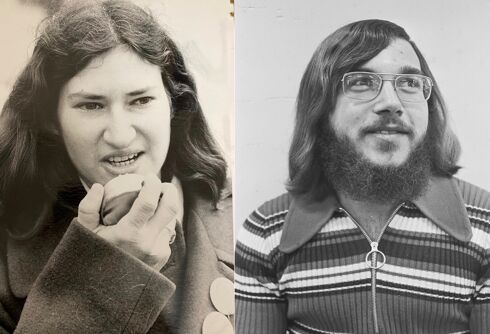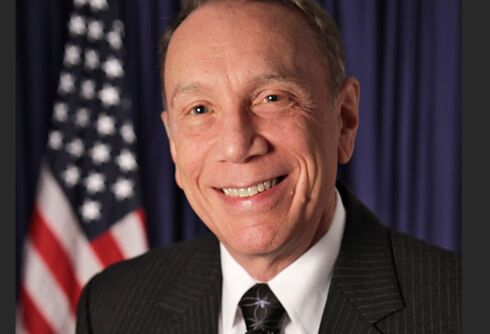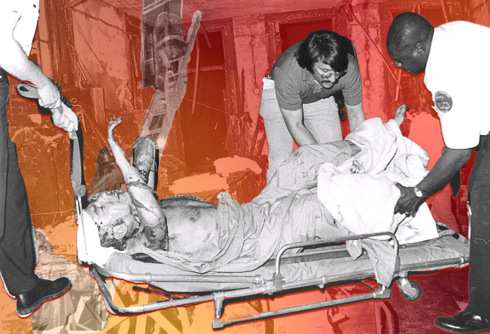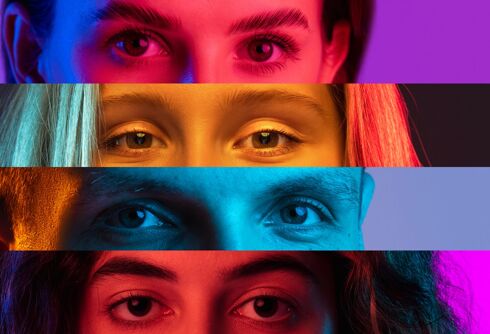Love takes off the masks that we fear we cannot live without and know we cannot live within. – James Baldwin.
It has only been a little more than a decade since we went from the passage of Prop 8 which banned marriage equality in California to an out married gay man running for President of the United States.
For as long as there have been people attracted to the same gender – and there have always been people attracted to the same gender, regardless of whatever varying terms were used to describe them from one place or time to another – there seem to have been examples of long relationships developing and a desire to formalize the relationships in some way.
Like the distance to an object or another person in real time, the farther one is from figures in history the harder it is to be certain what one sees, particularly when one’s perception is colored by what one thinks or wants to believe existed.
Never Miss a Beat
Subscribe to our newsletter to stay ahead of the latest LGBTQ+ political news and insights.
While historians continue to debate whether royal servants Khnumhotep and Niankhkhnum, buried together in an Egyptian tomb circa 2400 BC, were lovers or brothers, even twins, and whether the poet Sappho (circa 630 – circa 570 BC) was attracted to men, women, or both – even as the universality of the word “lesbian” which derives from her birthplace, the Isle of Lesbos, persists – there seems to be a consensus that what came to be called the Sacred Band of Thebes did exist; 150 pair of lovers, also known as “the 300,” in the army of the ancient Greek city-state.
And if there were only some way of contriving that a state or an army should be made up of lovers and their beloved, they would be the very best governors of their own city, abstaining from all dishonour, and emulating one another in honour; and when fighting at each other’s side, although a mere handful, they would overcome the world. For what lover would not choose rather to be seen by all mankind than by his beloved, either when abandoning his post or throwing away his arms? He would be ready to die a thousand deaths rather than endure this. Or who would desert his beloved or fail him in the hour of danger? – Plato, Symposium
Fast-forwarding through other historical figures such as Roman emperor Hadrian and his Greek beloved, Antinous, and the still-debated evidence of the late John Boswell in The Marriage of Likeness: Same-Sex Unions in Pre-Modern Europe blessed by the Church, we come to the molly houses of London dating to at least the 1720s.
According to historian Rictor Norton, Mother Clap’s Molly House: The Gay Subculture in England 1700-1830, “molly,” derived from Latin, was a pejorative term for gay men but one which they also sometimes used for each other. Molly houses were meeting places for working-class gay men that varied from public taverns to private rooms.
At least two molly houses were public houses run by a pair of gay men who were ‘married’ to one another. For example, a molly pub in King Street, Westminster, was kept by Robert Whale and his partner York Horner.
Norton also writes that “in 1810 Reverend John Church, a Baptist minister, used to bless marriages between gay men [and] published a sermon on the importance of love and friendship between men.”
Oh, how my heart longs after a companion & how I often wish for an establishment of my own, but I may then be too old to attach anyone & my life shall have passed in that dreary solitude I so ill endure. – Anne Lister.

In 1870, Karl Heinrich Ulrichs, the world’s first gay rights activist, published a pamphlet in Germany in which he suggested that gay men, whom he called “Urnings,” might marry.
In 1876, American poet Walt Whitman gave a “friendship ring” to young Harry Stafford whom he often called “my darling boy,” and wrote on June 18, 1877: “Dear Harry, not a day or night passes but I think of you. . . . Dear son, how I wish you could come in now, even if but for an hour & take off your coat, & sit on my lap.”
Often quarreling, Stafford returned the ring several times only to ask for it back, saying in a November 17, 1877, letter: “I wish you would put the ring on my finger again . . . . You know when you put it on there was but one thing to part it from me and that was death.”
Marriage was frequently the subject of articles in the earliest continuing gay American periodicals including ONE, Mattachine Review, and The Ladder. The August 1953 issue of ONE was the first serious discussion in a national publication of same-sex marriage. Its author, E.B. Saunders argued that the movement should stop ignoring the subject and start fighting for the right.
“What a logical and convincing means of assuring society that [we] are sincere in wanting respect and dignity!”

[L]etter writers echoed the ‘Homosexual Marriage?’ article by describing long-term partnerships with persons of the same gender conceptualized as marriages, despite the absence of legal recognition. [But] maintaining a heterosexual front to society was more difficult while participating in a lesbian or gay marriage. – Craig Loftin, Masked Voices: Gay Men and Lesbians in Cold War America.
In June 1958, the Daughters of Bilitis (DOB) mailed a four-page questionnaire to its 500 subscribers to The Ladder. The results were published in the September 1959 issue. Among the 157 respondents, 72% were in a relationship with another woman, and 59% “have had homosexual relationships of ‘some permanency’ prior to this one.”
ONE magazine conducted a poll in 1961. Unlike the DOB poll it included the word “marriage.” According to Loftin, among 388 male respondents, “mostly young adults in their 20s and 30s,” 42 percent had been in a same-sex “marriage” for at least a year.
Another 9 percent reported they were in a “same sex marriage” of less than a year. Average “marriage” lengths were between three and six years. Approximately half “agreed that the word ‘marriage’ described at least one of their long-term same-sex relationships.”

Soon after 28- yr. old Rev. Troy Perry founded the Metropolitan Community Church of Los Angeles for gay believers in October 1968, he began performing same-sex wedding ceremonies. A photo of one of them is included in a 1971 LIFE magazine article about the movement.

The same year in New York, members of Gay Activists Alliance (GAA) “zapped” the office of the city clerk, taking it over, after he threatened legal action against the pastor of the Church of the Beloved Disciple for performing “Ceremonies of Holy Union.” Captured on film by early gay rights pioneer Randy Wicker, they arrived with a large urn of coffee and a wedding cake decorated with two male figures and a lambda, GAA’s logo, made of sugar.
In Milwaukee that year, Manonia Evans and Donna Burkett applied for a marriage license.
 In 1973, Cora Latz and Etta Perkins had a wedding ceremony.
In 1973, Cora Latz and Etta Perkins had a wedding ceremony.

1974 saw the first nationally televised debate on marriage equality featuring National Gay Task Force and Mattachine Society of Washington cofounder Frank Kameny and soon-to-be-elected Massachusetts State Representative Elaine Noble arguing the affirmative.
In 1983, Karen Thompson began an eight-year legal battle over guardianship with the parents of her lover Sharon Kowalski who is a quadriplegic and severely brain-damaged from a car accident.
Berkeley, California, is first in nation to offer domestic partner recognition in 1984.
WE ARE TEACHING THE WORLD THAT THE WORD ‘COMMITMENT’ HAS ONLY TO DO WITH LOVE AND NOTHING TO DO WITH GENDER.
In 1987, Rev. Perry spoke at a ceremony hosted by lesbian comedian Robin Tyler during which Dr. Dina Bachelor simultaneously married some 2000 couples as a part of the Second National March on Washington for Lesbian and Gay Rights. One of the young men present explains that his partner of nine years had died of AIDS the year before.
“This is something he really would have wanted to participate in so I’m participating in his memory.”
“LOVE DON’T NEED A REASON. LOVE IS NEVER A CRIME. LOVE IS ALL WE HAVE FOR NOW. WHAT WE DON’T HAVE IS TIME.”
As the AIDS pandemic worsened and more and more gay men found themselves prevented from visiting their partners in the hospital because they weren’t a “legal relative,” the gay rights movement begins to focus on marriage equality like never before. Perry performed another mass wedding at the April 1993 March on Washington for Lesbian, Gay and Bi Equal Rights and Liberation.
That May, the Hawaii Supreme Court ruled that the state cannot deny same-sex couples the right to marry unless it finds ‘a compelling reason’ to do so, and ordered the issue back to the state legislature which passed an amendment banning gay marriages.
In December, “Love Don’t Need a Reason” coauthor Michael Callan dies, and the Massachusetts Supreme Judicial Court declares the ban on marriage equality contrary to the state constitution but marriages don’t begin until May 2004.
During his January 20, 2004, State of the Union address, President George W. Bush says: “Activist judges, however, have begun redefining marriage by court order, without regard for the will of the people and their elected representatives. On an issue of such great consequence, the people’s voice must be heard. If judges insist on forcing their arbitrary will upon the people, the only alternative left to the people would be the constitutional process. Our Nation must defend the sanctity of marriage.”
Listening in the House chamber was new San Francisco Mayor Gavin Newsom. Returning to the city, he decided to order the City Clerk to begin issuing marriage licenses to same-sex couples on February 12th.
The first couple married in a private, initially secret ceremony were Phyllis Lyon & Del Martin, then 79 & 82. They had co-founded the Daughters of Bilitis in 1955, the first lesbian rights group in the United States.
“I bawled my eyes out,” said Kate Kendell, one of the witnesses and Executive Director of the National Center for Lesbian Rights.

Then the new policy was announced publicly and exploded into headlines and newscasts. Couples immediately began descending upon City Hall both out of joy at the opportunity and fear that the courts would order the city to stop before they could get married. The numbers quickly grew larger and larger when word got out that San Francisco has no residency requirement. Soon couples began to arrive from other states and countries.
Young and old, of every color, day after day, night after night, with children, parents, grandparents, sisters, brothers, aunts, uncles, cousins, and friends, wrapping around City Hall’s block and around the hearts of people around the world.
“I’m an 87-yr. old grandmother wishing you well,” read the message that came with one of the many bouquets of flowers ordered from around America during the “Winter of Love” with instructions simply to be delivered to any of the gay couples waiting in line around the block, often in February rain, to get into San Francisco’s City Hall.
Even as the building stayed open late, and on Sundays, many camped out overnight for the next earliest opportunity for a license before the state court stopped them, and the ornate building’s hallways and grand staircase were filled for a month with couples immediately being married by an army of supportive ministers and quickly sworn in Deputy Marriage Commissioners.
Meanwhile in Los Angeles, Rev. Perry and his longtime partner, Phillip De Blieck, and Robin Tyler and her longtime partner, Diane Olson, filed a lawsuit against the County of Los Angeles for denying them marriage licenses.
Between that February 12th and March 11th when the courts ordered the process stopped, 4,096 couples from 46 states and 8 countries were married.
57% were lesbian couples, and 74% were over 35. Gavin Newsom received some 1200 death threats.
Ultimately, the courts nullified those marriages but Newsom’s legal team and others kept fighting, and many of the same couples were back in 2008 after the state supreme court ruled the state’s ban on same-sex marriages was unconstitutional.
Again, Lyon and Martin were the first to be married in San Francisco and Robin Tyler and Diane Olson were the first to be married in LA.
Marriage equality opponents got a new ban on the fall ballot nicknamed Prop H8TE. It infamously passed but between June 17th and November 4th some 18,000 gay couples married across the state, and this time the courts ruled them permanent.

So, when Del Martin passed that August after 56 years as Phyllis Lyon’s partner she was also her legal spouse.
The Tyler – Olson / Perry – De Blieck lawsuit, eventually consolidated with cases involving San Francisco couples, helped lead to the California State Supreme Court overturning Prop 8, and, in turn, the US Supreme Court upholding of that ruling and later ruling that all such state bans were unconstitutional.
I don’t want to die and not have married you.
Steve Hill was stationed with the US Army in Iraq in 2011. He wasn’t out to his unit and the military ban on gays, Don’t Ask, Don’t Tell, was still in effect. During video conference calls with his partner Josh Snyder back in Ohio, he’d sometimes have to suddenly disconnect when a new explosion came too close, leaving Josh thousands of miles away fearing not only that something might have happened to Steve but that he’d never be informed by the military if it did because legally he had no right.
Home on leave that May, Steve told him, “I don’t want to die and not have married you.” They drove to Washington DC where marriage had become legal, asking the local woman who was going to officiate for a suggestion of someplace special.
“Do you know about Leonard Matlovich?” They didn’t, but when she told them he had been the first gay service member to out himself to fight the ban in 1975, and that his grave and headstone reading “When I was in the military they gave me a medal for killing two men and a discharge for loving one” in Congressional Cemetery had become a place of pilgrimage, they decided to get married there.

They also didn’t know at the time that Leonard had purchased two plots side-by-side, the second for the lover he hoped to have one day but died from AIDS before he could. They have since purchased the plot next to him for their own eventual final resting place.
A number of gay couples are already interred there beneath shared gravestones, following Leonard’s 1987 admonition: “I believe we must be the same activists in our deaths that we were in life.”
One example, across the road from Leonard’s grave is a memorial bench for gay rights pioneers Barbara Gittings and Kay Tobin Lahusen. They had been together 46 years when Barbara passed in 2007. The bench reads, “Married in our hearts.” Kay is still very much living.

Steve and Josh later had to fight the state of Ohio for the right to join their last names, and became part of a class-action suit against the Defense of Marriage Act (DOMA). In 2013, they chartered a bus and took 25 gay and lesbian couples from five states with marriage bans to DC to be married in front of the Supreme Court building by the same wedding officiant, Tiffany Newman.

Owing to her high rank, now Major General Tammy Smith, US Army Reserve, made front-page news when she came out publicly in 2012. She and Tracey Hepner were married the same year, and continue to be outstanding role models for same-sex military couples.

Challenging her discharge over several years, US Air Force Major Margaret Witt drove the proverbial final nail in Don’t Ask, Don’t Tell’s coffin in 2010 when a judge ruled that the military could no longer discharge anyone simply because they were gay. Going forward, the “Witt Standard” would require the military to prove how each individual’s continued service would be a detriment.
In November 2012, Washington state voters legalized marriage equality. A month later she married her partner of nine years, Laurie Johnson. (Photo courtesy by Nate Gowdy.)

IN 2014, Bilerico Project founder (now LGBTQ Nation Editor-in-Chief) Bil Browning married fellow longtime activist Jerame Davis after 16 years together. Davis is now the Executive Director of Pride At Work, the national organization for LGBTQ union members.

As head of grassroots direct action group Get EQUAL, Robin McGehee also played a role in killing DADT, including being arrested at the White House, and in the fight for marriage equality. In 2015 she married Karen Johnston.

A 2017 Gallup poll estimated that 61% of same-sex, cohabiting couples in the US were married, up from 38% before the Supreme Court legalized same-sex marriage in June 2015, and 49% in 2016. In 2018, 61% of LGBT Americans polled by BuzzFeed were either already married or wanted to be someday.
I use the word ‘love’ here not merely in the personal sense but as a state of being, or a state of grace . . . in the tough and universal sense of quest and daring and growth. – James Baldwin.
Finally, a little more than ten years after gay rights pioneer Del Martin was first denied her right to marry her partner of over half-a-century, Pete Buttigieg, now a Democratic presidential candidate, finally decided to take off the mask he’d thought he couldn’t live without but which he realized he could no longer live within. Who, a little like Steve Snyder-Hill, saw the choice he had to make through the crucible of war.
I found myself sitting down at my desk to write a letter for my family to read in the event that I was killed during my upcoming deployment to Afghanistan. I was facing the possibility of not coming home – of going to my grave as a grown man, military officer, and sitting mayor, with no idea what it was like to be in love. – Pete Buttigieg
____________________________________________________________________________________
“Remember your roots, your history, and the forebears’ shoulders on which you stand.” – Marion Wright Edelman.















